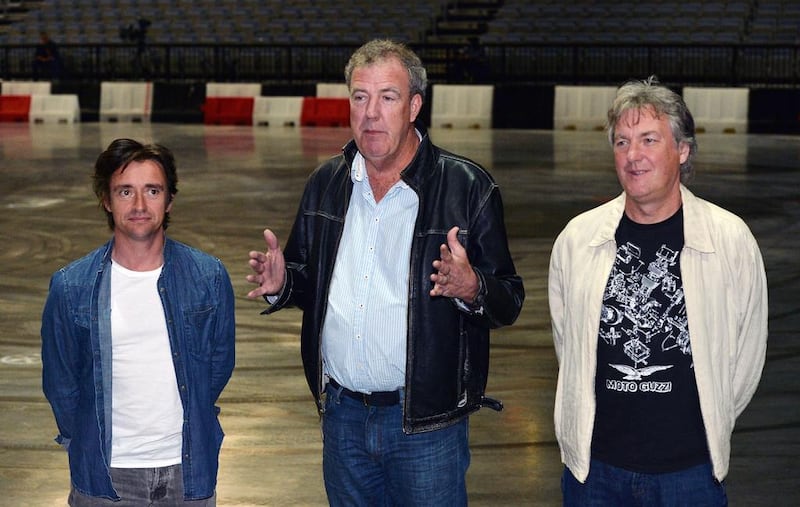Speak to most Top Gear fans and there's a slight air of trepidation leading up to the first series in over a decade without Jeremy Clarkson, James May and Richard Hammond at the wheel. After all, the trio turned a decrepit franchise into a globally popular, must-watch television show – and trying to replicate its mix of speeding cars, dry humour, irreverence and adventure with Chris Evans and Matt LeBlanc in charge is akin to the recent news that Guns N' Roses' Axl Rose is to replace Brian Johnson in AC/DC: there will be echoes of former glories, but Back in Black just won't be the same.
To their credit, both Evans and LeBlanc not only recognise the slightly poisoned chalice they've been passed, but have also explained how much they were fans of the show. It was Evans himself who put his finger on why the old Top Gear was loved so much. For all the comedy and all the times the team tried to destroy a Toyota Hilux, what always came through, he told us, was their "sincere and genuine" love of cars.
It was that enthusiasm for fast cars, odd cars, old cars and customised cars that underpinned Top Gear. Any presenter can get excited about testing the Jaguar F-Type R – as Clarkson did when he called it "outrageously fast … like driving around in poetry", last year. It would be the last car he would review on Top Gear. But just as important to the show was the real love for, say, a bashed up, £3,500 (Dh12,855) Fiat Barchetta shaking Hammond around the Middle East – "somehow, it's still here, still making me grin", he said, despite the bumper and radiator falling off. Perhaps there was something in the everyman accessibility of these cars taken to their absolute limits that really struck home with viewers.
And it was the films shot all over the world, from the Middle East to India and, memorably, America, which proved that Top Gear knew how to tell an entertaining story, whether in attempting to drive to the North Pole or finding the source of the Nile. The format was remarkably similar: take three cars somewhere ridiculous and make them do stupid things while bits fall off, Clarkson drives into Hammond, and May's car is spectacularly sabotaged, but the impressively high production values and commitment to entertainment made the specials, in particular, real televisual events. Although it did feel towards the end that the features were overly scripted, the sheer emotion writ large on Clarkson's face when he encountered the Sea Of Galilee at sunset wasn't manufactured.
Scripted or not, every one of the films also had a moment where the trio were doubled up in laughter. The natural camaraderie – even when they were smashing up each other’s cars and personalities – and easy humour meant that it felt like three mates having a laugh and, to a certain extent, testing what they could get away with on the BBC.
Sometimes that meant playing up to a certain stereotype of white, middle-aged Englishmen abroad, and sometimes they crossed the line. There was no excuse for the racially offensive language in the 2014 Myanmar special – and they rightly had to apologise. But there was always a paradox in the BBC seeming to encourage the irreverent attitude that made the show so compelling and yet having to continuously bat away complaints. The common observation was that Top Gear became an antidote to the tyranny of political correctness in the UK, but it is interesting that it still became a worldwide success broadcast to 214 countries. Perhaps that's because no one really took Clarkson and co. that seriously.
Apart from, of course, Amazon Prime, who gave the trio a staggering £160m budget last year to make three series of an online, streaming car show so difficult to name, they made a spoof video about their tribulations last month. It transpires that for legal reasons, it cannot have the word "gear" in the title, but much of the show, available in October, is likely to be familiar: the first episode has Clarkson, May and Hammond testing a Ferrari LaFerrari, McLaren P1 and Porsche 918 Spyder – all of which they have driven on Top Gear before. And Clarkson tweeting a picture of the trio next to three Reliant Rialtos, and a YouTube clip of him driving down a British high-street in a Monster Truck-style Mercedes convertible certainly suggests they won't be adverse to the more ridiculous end of the automotive industry either.
The slapstick adventures around the world are likely to remain if sightings of filming and Clarkson's tweets in Barbados, northern France, Marrakech, Germany and Jordan are a guide, while ex-Top Gear producer Andy Wilman revealed that the show would be able to "go rogue" and have no editorial pressure. Interesting, given that Top Gear revelled in the supposed high-wire act of upsetting the BBC and entertaining viewers. If there is no "danger" of upsetting any authorities, the show's atmosphere will necessarily change.
But that's no bad thing. Inevitably, Clarkson, May and Hammond's show will be compared with Top Gear, both past and present. Whether it's better or worse, of course, remains to be seen. There will be no Stig, Star In A Reasonably Priced Car or Cool Wall – all are trademarked to Top Gear. But maybe, just maybe, there's room for two car shows – and new as well as old heroes.
artslife@thenational.ae





